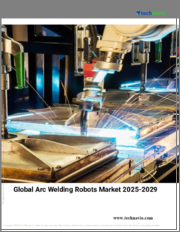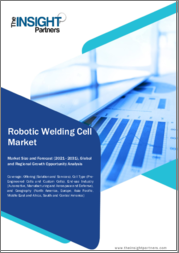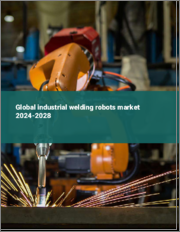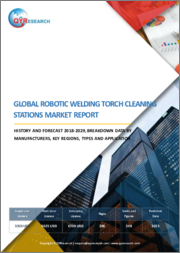
|
시장보고서
상품코드
1587695
세계의 로봇 용접 시장 예측 : 컴포넌트별, 유형별, 최종 사용자별, 지역별 분석(-2030년)Robotic Welding Market Forecasts to 2030 - Global Analysis By Component, Type, End User and By Geography |
||||||
Stratistics MRC에 따르면 세계의 로봇 용접 시장은 2024년에 102억 달러로 추정되고, 예측 기간 중 CAGR은 12.7%로 성장할 전망이며, 2030년에는 208억 달러에 이를 전망입니다.
로봇 용접은 용접 작업을 수행하기 위해 로봇 시스템을 채용하는 자동화 프로세스로, 제조의 효율과 정밀도를 대폭 향상시킵니다. 프로그래머블 로직 컨트롤러(PLC)와 인공지능 등 첨단 기술을 활용하는 로봇 용접 시스템은 높은 재현성과 최소한의 인적 개입으로 복잡한 용접을 수행할 수 있습니다. 이러한 로봇에는 MIG, TIG, 스폿 용접기 등 다양한 용접 도구가 장착되어 있어 다양한 재료와 구성으로 작업할 수 있습니다.
옥스포드 이코노믹스가 발표한 보고서에 따르면, 세계에서 사용된 로봇의 수는 지난 20년간 3배인 225만대에 달했습니다.
인더스트리 4.0 원칙 채택 확대
인더스트리 4.0 원칙의 채용 확대에 의해 사물인터넷(IoT), 인공지능(AI), 빅데이터 분석 등의 선진기술이 통합되어 로봇 용접이 대폭 강화되고 있습니다. 이러한 기술 혁신으로 용접 로봇의 실시간 모니터링 및 데이터 수집이 가능하며, 예지 보전이 촉진되고 작업 효과 속도가 향상됩니다. 스마트 센서와 연결 시스템을 통해 제조업체는 용접 프로세스를 분석하여 매개 변수를 최적화하고 결함을 줄이고 용접 품질을 향상시킬 수 있습니다. AI 알고리즘은 특정 재료 특성과 환경 조건에 따라 용접 기술을 적응시키고 일관된 결과를 보장할 수 있습니다.
규제 문제
규제상의 과제는 다양한 산업에서 로봇 용접 기술의 진보를 크게 방해하고 있습니다. 이러한 과제는, 자동화 시스템의 사용을 규제하는 엄격한 안전 기준, 컴플리언스 요건, 업계 특유의 규제에 기인하는 것이 많습니다. 예를 들어, 제조 업체는 지역에 따라 다른 노동 안전 단체와 환경 보호 기관에 의해 확립된 복잡한 프레임 워크를 탐색해야 합니다. 이것은 새로운 로봇 용접 시스템의 비용 증가와 승인 프로세스의 장기화로 이어질 수 있습니다. 그 결과, 많은 기업은 컴플라이언스 위반이나 잠재적인 법적 영향을 두려워해 로봇 용접 솔루션에 대한 투자를 주저하게 됩니다.
레이저 및 플라즈마 용접 기술의 출현
레이저 및 플라즈마 용접 기술의 출현은 정밀도, 속도 및 범용성을 향상시켜 로봇 용접 기능을 강화하고 있습니다. 레이저 용접은 집속된 광선을 이용하여 열 왜곡을 최소화한 고품질 용접부를 형성하기 때문에 복잡한 설계나 얇은 재료에 최적입니다. 이 정밀도에 의해 용접 후 가공 시간이 단축되고 전반적인 생산성이 향상됩니다. 플라즈마 용접은 고온의 아크를 발생시키기 위해 이온화 가스를 사용하므로 용융 특성이 뛰어나고 용접 특성을 보다 잘 제어할 수 있습니다. 로봇 시스템과 통합함으로써 두 기술 모두 용접 공정의 자동화를 촉진하고 인적 실수를 줄이고 생산량의 일관성을 높입니다.
통합 과제
로봇 용접의 통합 과제는 다양한 시스템과 기술을 결합하는 복잡성으로 인한 경우가 많습니다. 이러한 과제에는 로봇 팔, 용접 기기 및 제어 소프트웨어 간의 원활한 통신 확보가 포함되어 있으며 제조업체마다 크게 다를 수 있습니다. 비전 시스템 및 인공지능과 같은 첨단 기술을 기존 워크플로우에 통합하면 전개 프로세스가 복잡해지고 대규모 교육 및 적응이 필요할 수 있습니다. 또 레거시 시스템이나 기존 인프라와의 호환성에도 우려가 있으며 로봇 용접 솔루션의 확장성이 제한될 수 있습니다.
COVID-19의 영향 :
COVID-19의 대유행은 현대 제조업의 중요한 요소인 로봇 용접에 큰 영향을 미쳤습니다. 당초 공급망 혼란이 필수 부품의 생산과 납품을 정지시켜 프로젝트 지연을 발생시켜 전반적인 생산성에 영향을 미쳤습니다. 많은 제조 시설이 위생 규제로 인한 임시 조업 정지에 직면해 조업 능력의 저하와 노동력 부족으로 이어졌습니다. 팬데믹은 기업들이 효율성을 높이고 사람들에 대한 의존을 줄이려고 하는 가운데 자동화와 로봇 공학의 채택을 가속화시켰습니다. 이 시프트는 미래의 혼란에 직면하여 운영의 회복력을 확보하기위한 첨단 기술의 필요성을 강조했습니다.
예측 기간 동안 금속 불활성 가스 분야가 최대화될 전망
금속 불활성 가스 부문은 예측 기간 동안 최대 점유율을 차지할 것으로 예상됩니다. 로봇 MIG 용접 시스템은 정밀도와 일관성을 통합하여 제조업체가 가속된 속도로 고품질 용접을 달성할 수 있도록 합니다. 이러한 자동화된 솔루션은 위험한 환경에서 반복 작업을 처리하여 인적 오류를 줄이고 안전성을 향상시킵니다. 로봇 시스템의 적응성은 자동차에서 항공우주에 이르기까지 다양한 용도에 맞게 프로그래밍할 수 있기 때문에 생산 라인에 유연성을 제공합니다. 실시간 모니터링 및 적응 제어와 같은 고급 기능은 프로세스 효율성을 높이고 최적의 결과를 보장합니다.
예측기간 중 항공우주 및 방위 분야가 가장 높은 CAGR이 예상됩니다.
항공우주 및 방위 분야는 높은 구조적 무결성과 최소한의 중량을 필요로 하는 항공우주 부품의 복잡한 요구에 대응하기 때문에 예측기간 중에 급성장할 것으로 예측됩니다. 로봇 용접 시스템은 일관된 품질과 재현성을 제공하여 인위적 실수의 위험을 크게 줄이고 용접 강도를 향상시킵니다. 첨단 센서와 머신러닝 알고리즘을 채택함으로써 이러한 로봇은 재료 및 용접 조건의 변화에 실시간으로 적응하여 최적의 성능을 보장할 수 있습니다. 또한, 용접 공정의 자동화는 생산 사이클의 가속화로 이어져 리드 타임과 운영 비용을 절감합니다. 이는 신속한 프로토타입과 생산이 필수적인 방위 분야에서 특히 중요합니다.
최대 점유율을 차지하는 지역
아시아태평양은 예측 기간을 통해 동 시장에서 가장 큰 점유율을 차지할 것으로 보입니다. 일본, 한국, 중국과 같은 국가들이 학계, 산업계, 정부의 자원과 전문 지식을 결집하고 선도하고 있습니다. 이러한 파트너십은 자동화 시스템 및 인공지능 통합과 같은 용접 기술의 진보에 중점을 두어 정확도 향상과 생산 비용 절감을 실현하고 있습니다. 협력적인 노력은 지식 교환을 촉진하고 자동차 및 항공우주 등 다양한 분야에 걸친 최첨단 기술의 신속한 적응을 가능하게 합니다. 또한 이러한 협력 관계 속에서 지속 가능한 실천을 중시함으로써 환경 친화적인 용접 솔루션이 촉진되어 세계의 환경 기준을 따릅니다.
CAGR이 가장 높은 지역 :
유럽은 안전 기준을 수립하고, 혁신을 추진하며, 지속가능성을 장려함으로써 예측 기간 동안 가장 높은 CAGR을 나타낼 것으로 추정됩니다. 정부의 규제는 용접 공정이 엄격한 안전 및 환경 기준을 충족하도록 보장하여 노동자를 보호하고 생태계에 미치는 영향을 줄입니다. 노동력 스킬 업을 목표로 한 이니셔티브는 직원들이 첨단 로봇 시스템을 조작하기에 충분한 장비를 확보하고 지속적인 개선과 혁신 문화를 육성합니다. 그 결과, 유럽의 로봇 용접 업계는 보다 효율적이고 환경 친화적이 되어 세계 시장의 리더로서의 지위를 확립하고 있습니다.
사용자 정의 무료 제공 :
이 보고서를 구독하는 고객은 다음 무료 맞춤설정 옵션 중 하나를 사용할 수 있습니다.
- 기업 프로파일
- 추가 시장 기업의 종합적 프로파일링(3개사까지)
- 주요 기업의 SWOT 분석(3개사까지)
- 지역 세분화
- 고객의 관심에 응한 주요국 시장 추계, 예측 및 CAGR(주 : 타당성 확인에 따름)
- 경쟁 벤치마킹
- 제품 포트폴리오, 지리적 존재, 전략적 제휴에 기반한 주요 기업 벤치마킹
목차
제1장 주요 요약
제2장 서문
- 개요
- 이해관계자
- 조사 범위
- 조사 방법
- 데이터 마이닝
- 데이터 분석
- 데이터 검증
- 조사 접근
- 조사 정보원
- 1차 조사 정보원
- 2차 조사 정보원
- 전제조건
제3장 시장 동향 분석
- 성장 촉진요인
- 억제요인
- 기회
- 위협
- 최종 사용자 분석
- 신흥 시장
- COVID-19의 영향
제4장 Porter's Five Forces 분석
- 공급기업의 협상력
- 구매자의 협상력
- 대체품의 위협
- 신규 진입업자의 위협
- 경쟁 기업간 경쟁 관계
제5장 세계의 로봇 용접 시장 : 컴포넌트별
- 하드웨어
- 서비스
- 소프트웨어
제6장 세계의 로봇 용접 시장 : 유형별
- 스폿 용접
- 아크 용접
- 금속 불활성 가스
- 텅스텐 불활성 가스
- 레이저 용접
- 기타 유형
제7장 세계의 로봇 용접 시장 : 최종 사용자별
- 항공우주 및 방위
- 전기 및 전자
- 자동차 및 운송
- 석유 및 가스
- 기타 최종 사용자
제8장 세계의 로봇 용접 시장 : 지역별
- 북미
- 미국
- 캐나다
- 멕시코
- 유럽
- 독일
- 영국
- 이탈리아
- 프랑스
- 스페인
- 기타 유럽
- 아시아태평양
- 일본
- 중국
- 인도
- 호주
- 뉴질랜드
- 한국
- 기타 아시아태평양
- 남미
- 아르헨티나
- 브라질
- 칠레
- 기타 남미
- 중동 및 아프리카
- 사우디아라비아
- 아랍에미리트(UAE)
- 카타르
- 남아프리카
- 기타 중동 및 아프리카
제9장 주요 발전
- 계약, 파트너십, 협업 및 합작투자(JV)
- 인수 및 합병
- 신제품 발매
- 사업 확대
- 기타 주요 전략
제10장 기업 프로파일링
- ABB Ltd
- Daihen Corporation
- Estun Automation Co., Ltd
- Fanuc Corporation
- Kawasaki Heavy Industries, Ltd
- Kuka AG
- Mitsubishi Electric Corporation
- Panasonic Corporation
- Siasun Robot & Automation Co. Ltd
- Toshiba Corporation
- Yaskawa Electric Corporation
According to Stratistics MRC, the Global Robotic Welding Market is accounted for $10.2 billion in 2024 and is expected to reach $20.8 billion by 2030 growing at a CAGR of 12.7% during the forecast period. Robotic welding is an automated process that employs robotic systems to perform welding tasks, significantly enhancing efficiency and precision in manufacturing. Utilizing advanced technologies such as programmable logic controllers (PLCs) and artificial intelligence, robotic welding systems can execute complex welds with high repeatability and minimal human intervention. These robots are equipped with various welding tools, including MIG, TIG, and spot welding machines, allowing them to work with different materials and configurations.
According to a report published by Oxford Economics, the number of robots in use worldwide multiplied three-fold over the past 2 decades to 2.25 million.
Market Dynamics:
Driver:
Growing adoption of industry 4.0 principles
Growing adoption of Industry 4.0 principles is substantially enhancing robotic welding by integrating advanced technologies such as the Internet of Things (IoT), artificial intelligence (AI) and big data analytics. These innovations enable real-time monitoring and data collection from welding robots, facilitating predictive maintenance and improving operational efficiency. With smart sensors and connected systems, manufacturers can analyze welding processes to optimize parameters, reducing defects and improving weld quality. AI algorithms can adapt welding techniques based on specific material properties and environmental conditions, ensuring consistent results.
Restraint:
Regulatory challenges
Regulatory challenges significantly hinder the advancement of robotic welding technology across various industries. These challenges often stem from stringent safety standards, compliance requirements, and industry-specific regulations that govern the use of automated systems. For instance, manufacturers must navigate complex frameworks established by occupational safety organizations and environmental protection agencies, which can vary by region. This can lead to increased costs and lengthy approval processes for new robotic welding systems. As a result, many businesses may hesitate to invest in robotic welding solutions, fearing non-compliance or potential legal ramifications.
Opportunity:
Emergence of laser and plasma welding technologies
The emergence of laser and plasma welding technologies is enhancing robotic welding capabilities by improving precision, speed, and versatility. Laser welding utilizes focused beams of light to create high-quality welds with minimal heat distortion, making it ideal for intricate designs and thin materials. This precision reduces post-weld processing time and enhances overall productivity. Plasma welding employs ionized gas to produce a high-temperature arc, allowing for deeper penetration and better control over weld characteristics. When integrated with robotic systems, both technologies facilitate automation in welding processes, reducing human error and increasing consistency in output.
Threat:
Integration challenges
Integration challenges in robotic welding often stem from the complexity of combining various systems and technologies. These challenges include ensuring seamless communication between robotic arms, welding equipment, and control software, which can vary significantly across manufacturers. The integration of advanced technologies such as vision systems and artificial intelligence into existing workflows can complicate the implementation process, requiring extensive training and adaptation. There are also concerns regarding compatibility with legacy systems and existing infrastructure, which can limit the scalability of robotic welding solutions.
Covid-19 Impact:
The COVID-19 pandemic significantly impacted robotic welding, a critical component of modern manufacturing. Initially, supply chain disruptions halted the production and delivery of essential components, causing delays in projects and affecting overall productivity. Many manufacturing facilities faced temporary shutdowns due to health regulations, leading to reduced operational capacity and workforce shortages. The pandemic accelerated the adoption of automation and robotics as companies sought to enhance efficiency and reduce reliance on human labor. This shift emphasized the need for advanced technology to ensure operational resilience in the face of future disruptions.
The Metal Inert Gas segment is expected to be the largest during the forecast period
Metal Inert Gas segment is expected to dominate the largest share over the estimated period. Robotic MIG welding systems integrate precision and consistency, enabling manufacturers to achieve high-quality welds at accelerated speeds. These automated solutions reduce human error and improve safety by handling repetitive tasks in hazardous environments. The adaptability of robotic systems allows them to be programmed for various applications, from automotive to aerospace, providing flexibility in production lines. Advanced features, such as real-time monitoring and adaptive control, enhance process efficiency and ensure optimal results.
The Aerospace & Defense segment is expected to have the highest CAGR during the forecast period
Aerospace & Defense segment is estimated to grow at a rapid pace during the forecast period as it addresses the complex demands of aerospace components, which require high structural integrity and minimal weight. Robotic welding systems offer consistent quality and repeatability, significantly reducing the risk of human error and improving weld strength. By employing advanced sensors and machine learning algorithms, these robots can adapt in real time to variations in materials and welding conditions, ensuring optimal performance. Additionally, the automation of welding processes leads to faster production cycles, reducing lead times and operational costs. This is particularly vital in the defense sector, where rapid prototyping and production are essential.
Region with largest share:
Asia Pacific region is poised to hold the largest share of the market throughout the extrapolated period. Countries like Japan, South Korea, and China are leading the way by pooling resources and expertise from academia, industry, and government. These partnerships focus on advancing welding technologies, such as automated systems and artificial intelligence integration, improving precision and reducing production costs. Collaborative efforts facilitate knowledge exchange, enabling the rapid adaptation of cutting-edge techniques across various sectors, including automotive and aerospace. The emphasis on sustainable practices within these collaborations also promotes eco-friendly welding solutions, aligning with global environmental standards.
Region with highest CAGR:
Europe region is estimated to witness the highest CAGR during the projected time frame by establishing safety standards, promoting innovation, and encouraging sustainability. Government regulations ensure that welding processes meet stringent safety and environmental criteria, thereby protecting workers and reducing ecological impact. Initiatives aimed at upskilling the workforce ensure that employees are well-equipped to operate sophisticated robotic systems, fostering a culture of continuous improvement and innovation. As a result, the European robotic welding industry is becoming more efficient and eco-friendly, positioning itself as a leader in the global market.
Key players in the market
Some of the key players in Robotic Welding market include ABB Ltd, Daihen Corporation, Estun Automation Co., Ltd, Fanuc Corporation, Kawasaki Heavy Industries, Ltd, Kuka AG, Mitsubishi Electric Corporation, Panasonic Corporation, Siasun Robot & Automation Co. Ltd, Toshiba Corporation and Yaskawa Electric Corporation.
Key Developments:
In December 2022, Alma and Yaskawa Europe entered into a partnership agreement for off-line programming of welding robots. Off-line programming, which enables a robot to be graphically programmed from a virtual scene and its movements to be simulated, is easier to learn than an alternative to traditional programming.
In December 2022, OTC Daihen unveiled a several pre-engineered, production robotic arc-welding systems packed into its booth, all featuring robotic arms matched with welding power supplies and part-positioning equipment, and committing to deliver low-spatter welding on a variety of materials.
In February 2021, Ola entered into a partnership with ABB for the implementation of robotics & automation solutions in its mega-factory in India, which is slated to roll out the much-anticipated Ola electric scooter. As per the partnership, Ola will utilize ABB's automation solutions in its factory's key manufacturing process lines including the painting & welding lines while the ABB robots will be deployed extensively for the battery & motor assembly lines.
Components Covered:
- Hardware
- Services
- Software
Types Covered:
- Spot Welding
- Arc Welding
- Metal Inert Gas
- Tungsten Inert Gas
- Laser Welding
- Other Types
End Users Covered:
- Aerospace & Defense
- Electrical & Electronics
- Automotive & Transportation
- Oil & Gas
- Other End Users
Regions Covered:
- North America
- US
- Canada
- Mexico
- Europe
- Germany
- UK
- Italy
- France
- Spain
- Rest of Europe
- Asia Pacific
- Japan
- China
- India
- Australia
- New Zealand
- South Korea
- Rest of Asia Pacific
- South America
- Argentina
- Brazil
- Chile
- Rest of South America
- Middle East & Africa
- Saudi Arabia
- UAE
- Qatar
- South Africa
- Rest of Middle East & Africa
What our report offers:
- Market share assessments for the regional and country-level segments
- Strategic recommendations for the new entrants
- Covers Market data for the years 2022, 2023, 2024, 2026, and 2030
- Market Trends (Drivers, Constraints, Opportunities, Threats, Challenges, Investment Opportunities, and recommendations)
- Strategic recommendations in key business segments based on the market estimations
- Competitive landscaping mapping the key common trends
- Company profiling with detailed strategies, financials, and recent developments
- Supply chain trends mapping the latest technological advancements
Free Customization Offerings:
All the customers of this report will be entitled to receive one of the following free customization options:
- Company Profiling
- Comprehensive profiling of additional market players (up to 3)
- SWOT Analysis of key players (up to 3)
- Regional Segmentation
- Market estimations, Forecasts and CAGR of any prominent country as per the client's interest (Note: Depends on feasibility check)
- Competitive Benchmarking
- Benchmarking of key players based on product portfolio, geographical presence, and strategic alliances
Table of Contents
1 Executive Summary
2 Preface
- 2.1 Abstract
- 2.2 Stake Holders
- 2.3 Research Scope
- 2.4 Research Methodology
- 2.4.1 Data Mining
- 2.4.2 Data Analysis
- 2.4.3 Data Validation
- 2.4.4 Research Approach
- 2.5 Research Sources
- 2.5.1 Primary Research Sources
- 2.5.2 Secondary Research Sources
- 2.5.3 Assumptions
3 Market Trend Analysis
- 3.1 Introduction
- 3.2 Drivers
- 3.3 Restraints
- 3.4 Opportunities
- 3.5 Threats
- 3.6 End User Analysis
- 3.7 Emerging Markets
- 3.8 Impact of Covid-19
4 Porters Five Force Analysis
- 4.1 Bargaining power of suppliers
- 4.2 Bargaining power of buyers
- 4.3 Threat of substitutes
- 4.4 Threat of new entrants
- 4.5 Competitive rivalry
5 Global Robotic Welding Market, By Component
- 5.1 Introduction
- 5.2 Hardware
- 5.3 Services
- 5.4 Software
6 Global Robotic Welding Market, By Type
- 6.1 Introduction
- 6.2 Spot Welding
- 6.3 Arc Welding
- 6.4 Metal Inert Gas
- 6.5 Tungsten Inert Gas
- 6.6 Laser Welding
- 6.7 Other Types
7 Global Robotic Welding Market, By End User
- 7.1 Introduction
- 7.2 Aerospace & Defense
- 7.3 Electrical & Electronics
- 7.4 Automotive & Transportation
- 7.5 Oil & Gas
- 7.6 Other End Users
8 Global Robotic Welding Market, By Geography
- 8.1 Introduction
- 8.2 North America
- 8.2.1 US
- 8.2.2 Canada
- 8.2.3 Mexico
- 8.3 Europe
- 8.3.1 Germany
- 8.3.2 UK
- 8.3.3 Italy
- 8.3.4 France
- 8.3.5 Spain
- 8.3.6 Rest of Europe
- 8.4 Asia Pacific
- 8.4.1 Japan
- 8.4.2 China
- 8.4.3 India
- 8.4.4 Australia
- 8.4.5 New Zealand
- 8.4.6 South Korea
- 8.4.7 Rest of Asia Pacific
- 8.5 South America
- 8.5.1 Argentina
- 8.5.2 Brazil
- 8.5.3 Chile
- 8.5.4 Rest of South America
- 8.6 Middle East & Africa
- 8.6.1 Saudi Arabia
- 8.6.2 UAE
- 8.6.3 Qatar
- 8.6.4 South Africa
- 8.6.5 Rest of Middle East & Africa
9 Key Developments
- 9.1 Agreements, Partnerships, Collaborations and Joint Ventures
- 9.2 Acquisitions & Mergers
- 9.3 New Product Launch
- 9.4 Expansions
- 9.5 Other Key Strategies
10 Company Profiling
- 10.1 ABB Ltd
- 10.2 Daihen Corporation
- 10.3 Estun Automation Co., Ltd
- 10.4 Fanuc Corporation
- 10.5 Kawasaki Heavy Industries, Ltd
- 10.6 Kuka AG
- 10.7 Mitsubishi Electric Corporation
- 10.8 Panasonic Corporation
- 10.9 Siasun Robot & Automation Co. Ltd
- 10.10 Toshiba Corporation
- 10.11 Yaskawa Electric Corporation



















